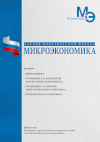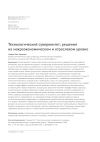Technological Sovereignty: Solutions at the Macroeconomic and Industry Level
DOI: 10.33917/mic-2.109.2023.19-33
The problem of ensuring technological sovereignty in the Russian economy is considered. The purpose of the study is to identify the features of technological development and assess technological sovereignty at the sectoral and macroeconomic levels of management. The methodology is the theory of technological change, comparative and empirical, structural analysis. The general result of applying these approaches is proposals at the macroeconomic level and for sectoral policy that contribute to increasing the technological independence of the state. Ensuring technological sovereignty comes down not only to the substitution of technology imports, but, more importantly, to the resuscitation of the domestic technological base. Particular emphasis should be placed on overcoming the existing and chronic problems of the technological development of the Russian economy. These include: the pseudo effect of technological dualism, the low sensitivity of manufacturability to investment in new technologies, the low share of the knowledge economy, and the inefficient structure of technological modes. Increasing the rate of accumulation of fixed capital and bringing it to the rate of savings is a false goal, since the structure of the distribution of investments, and not their share, that is, the volume, is important for long-term growth. Measures for financial independence proposed at the macro level will determine the solution of the problem of technological sovereignty, but the proposed recipes are very streamlined, not specific and do not solve the problem of sovereign financial development, since the placement of financial resources in external instruments, the application of the previous targeting policy and the budget rule remain, as well as the monetary policy of curbing growth. These conditions will hinder the solution of the problem of ensuring technological sovereignty in Russia.
References:
1. Glazyev S.Yu. Nanotechnologies as a key factor in the new technological order in the economy / Ed. Academician of the Russian Academy of Sciences S.Yu. Glazyev and Professor V.V. Kharitonov. M.: Trovant, 2009. 304 p.
2. Lvov D.S., Glaziev S.Yu. Theoretical and applied aspects of STP management. Economics and Mathematical Methods. 1986;5:793–804. (In Russ.).
3. Mensch G. Technological stalemate: innovations overcome depression. M.: Economics, 2001. 211 p.
4. Perez K. Technological revolutions and financial capital. Dynamics of bubbles and periods of prosperity. M.: Delo, 2011. 232 p.
5. Sukharev O.S. Economics of technological development. M.: Finance and statistics, 2008. 480 p.
6. Sukharev O.S. Economics of industry, technology and intellectual firms. M.: Lenand, 2022. 304 p.
7. Antonelli C., Gehringer A. Technological change, rent and income inequalities: A Schumpeterian approach. Technological Forecasting & Social Change. 2017;115:85–98.
8. Breschi S., Malerba F., Orsenigo L. Technological Regimes and Schumpeterian Patterns of Innovation. The Economic Journal. 2000;110 (463):388–410.
9. Crafts N. The First Industrial Revolution: Resolving the Slow Growth. Rapid Industrialization Paradox / Papers and Proceedings of the Nineteenth Annual Congress of the European Economic Association. Journal of the European Economic Association. 2005;3(2/3):525–534.
10. Dosi G. Technical Change and Industrial Transformation: The Patterns of Industrial Dynamics. In: Technical Change and Industrial Transformation. Palgrave Macmillan, London, 1984. 338 p.
11. Franka A.G., Dalenogareb L.S., Ayala N.F. Industry 4.0 technologies: Implementation patterns in manufacturing companies. International Journal of Production Economics. 2019;210:15–26.
12.Gabardo F.A., Pereima J.B., Einloft P. The incorporation of structural change into growth theory: A historical appraisal. EconomiA. 2017;18(3):392–410.
13. Lu Y. Industry 4.0: A survey on technologies, applications and open research issues. Journal of Industrial Information Integration. 2017;6:1–10.
14. Philbeck T., Davis Т. The Fourth Industrial Revolution. Journal of International Affairs. 2019;72(1):17–22.
15. Rifkin J. The Third Industrial Revolution: How Lateral Power Is Transforming Energy, the Economy, and the World // St. Martin’s Griffin Pbl, 2011. 304 р.



